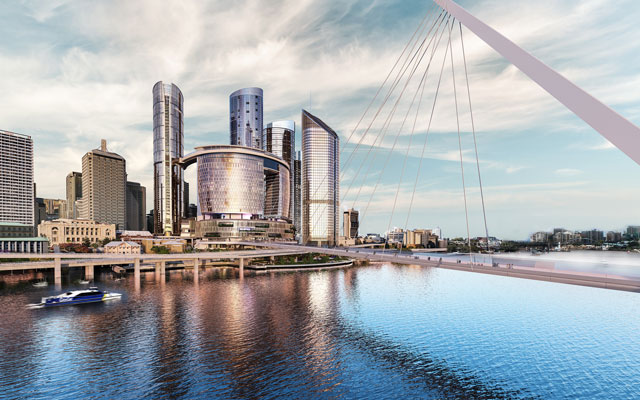Development plans for Brisbane are elevating the city’s reputation among Asian incentive programme decision makers
Yes, that’s a soaring skydeck but it’s not in Singapore; it’s in Brisbane. Or at least it will be soon, as part of a massive development underway in the city to boost tourism and significantly up the ante as a destination for incentive programmes.
Brisbane has an impressive A$15 billion-plus (US$10.9 billion) currently in major projects either under construction or planned to 2026. This includes a new parallel runway at Brisbane Airport and a new International Cruise Ship Terminal by next year, and a much anticipated Queen’s Wharf integrated resort which will change the city’s skyline and give Australia’s third biggest city a leisure and entertainment precinct worthy of incentive tourism prospects.

The airport redevelopment itself will cost A$3.8 billion, with A$1.3 billion going into the new runway which will double the airport’s capacity, drawing comparisons to Singapore’s Changi Airport and Hong Kong Airport. Once completed next year, it will be lauded the best runway system in Australia.
“The parallel runway at the airport is really critical,” said Juliet Alabaster, general manager of business events for Brisbane Marketing.
“The more aviation access we can get into the city, the more opportunity we have to attract incentive groups,” she said.
In fact, optimism about the airpot’s developments and Brisbane’s new offerings have already begun working its charm to secure additional flights, according to Brisbane Airport’s executive general manager of aviation development and partnerships, Jim Parashos.
“It’s (been) a key enabler for us to attract new services,” he said.
“Particularly for key growth markets in Asia, where we can now serve long-range narrow body aircraft like the A321neo. Even in the lead up to the new runway opening we’ve had most of our growth come in from Asia including Hainan Airlines from Shenzhen, Malaysia Airlines resuming its four-weekly service, Philippine Airlines starting non-stop flights, and in June the launch of Thai AirAsia X flights.”
As for that skydeck, which will be the jewel in the crown when the Queen’s Wharf integrated resort is finished in 2022, imagine a connected space of five- and six-star hotels, 50 bars and restaurants, a cross-river pedestrian bridge, boutique shopping, vast green spaces, casino, meeting spaces, theatre and nine restored heritage buildings.
The arc-shaped skydeck will offer 360-degree views of Brisbane river and the city, provide spaces for events, and is anticipated to be the destination’s hot new selfie spot.
This is in addition to infrastructure developments in the next five years including a tunnel rail line that will unlock bottlenecks in the city’s transport network and a new rapid transit system called Brisbane Metro.
Already a lure for the events market is the recently completed Howard Smith Wharves which revitalised an 1880s-era site and now offers a five-star Art Series Hotel, an exhibition and events centre, craft brewery and 2.7 hectares of public space for markets and festivals.
There’s also new hotel stock to whet planners’ appetite.
Thirty new hotels will be delivered between 2014 and 2024, which is good news even for established accommodation like Brisbane Marriott, which has just celebrated 21 years and finished a major redevelopment earlier this year (see Marketplace, page 8).
“I think we’ve got some of the best new hotels in Australia which makes it so much easier for us to sell what Brisbane can offer to all customers,” remarked general manager John Douglas.
So what turned Brisbane on its head? “Probably three years ago we really looked at our strategy as the CVB for the city and we hadn’t been doing a lot in the incentive space. We didn’t have the products and we were seen as a corporate town,” said Alabaster.
Fast forward to hosting Tourism Australia’s signature incentive event Dreamtime in 2017 with 100 international incentive buyers as guests, and Brisbane was “leapfrogged into consideration”.
Douglas, Parashos and Alabaster also speak from the same page when it comes to the Asian market, confirming that it is front and centre of their marketing strategies. From Chinese language wayfinders at Brisbane Airport to Marriott’s Chinese-friendly Liyiu programme, the city’s key tourism stakeholders are fully on board with Brisbane Marketing’s Asia-centric vision. And the efforts are paying off.
“Last financial year we only placed 14 financial bids,” said Alabaster.
“For this year we’re already up to 26. So I guess we’re starting to see the fruits of our labour in terms of opportunities coming through those relationships that we are growing and building on. In terms of percentage, in the past our overall economic impact figure for the bureau would’ve been five per cent – small.
“This year it’s moving towards 20 per cent of what we (anticipate winning) for the city,” she continued, also noting that a lot of business events are booked independent of the bureau.
The developments have earned an approving nod from Tourism Australia’s former managing director John O’Sullivan, who noted that Brisbane is making an impression in Asia.
“On my travels throughout Asia, (the Queen’s Wharf development) is a project that has captured the imagination of many of our Asian partners,” he said. “The expansion of Brisbane Airport with the second runway will give the city the potential to become the nation’s gateway to Asia”.
So towering business event possibilities for Brisbane? You might say they’re sky-high.





















